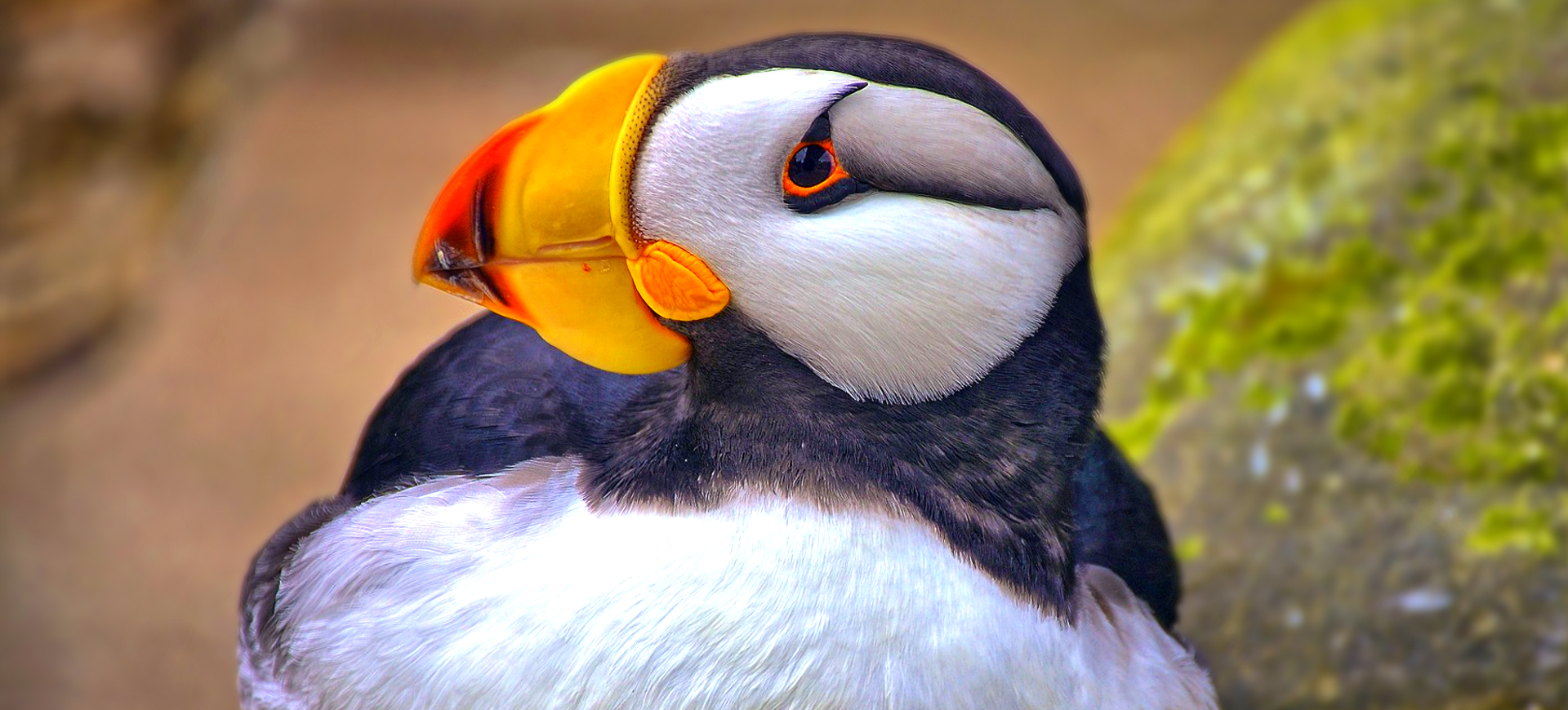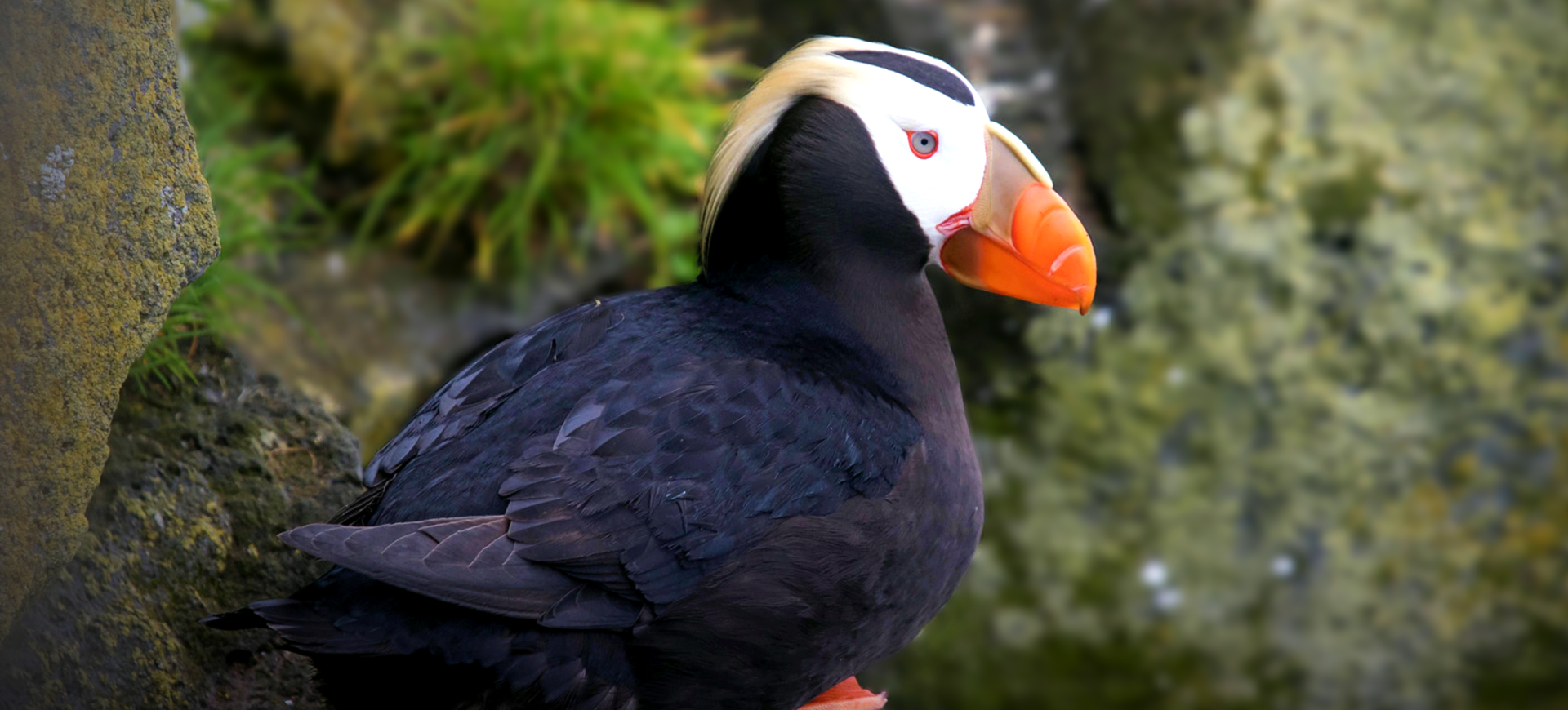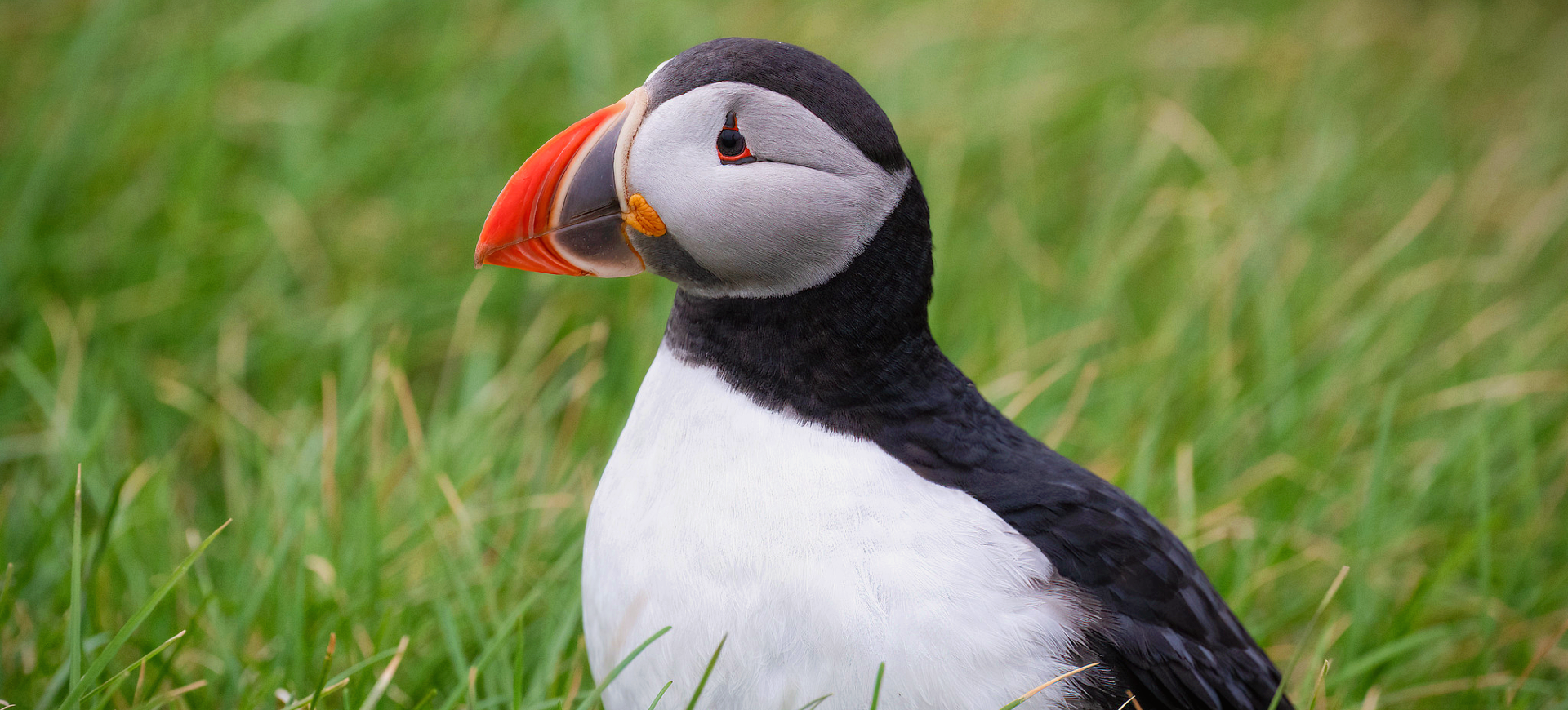Overview
The Rhinoceros Auklet, scientifically known as Cerorhinca monocerata, is a unique seabird from the auk family. Unlike its puffin relatives, this species is distinguished by a prominent horn-like extension on its bill, which is most visible during the breeding season. These medium-sized birds are predominantly grey with a white belly, showcasing a stout body adept for flying and diving. They inhabit the North Pacific, from the coasts of California up to Alaska and across to Asia, nesting in burrows on isolated, forested islands.
Rhinoceros Auklets are exceptional divers, using their wings to propel themselves underwater in pursuit of fish and zooplankton. They are nocturnal feeders, which helps reduce competition for food and predation risk. During the breeding season, their social nature is evident as they gather in large colonies on offshore islands, engaging in communal nesting and raising their young. The horn on their bill and a facial plume of feathers play a crucial role in mate selection and breeding rituals.
The species faces threats from habitat destruction, oil spills, and entanglement in fishing nets, which have impacted their populations in some areas. Despite these challenges, Rhinoceros Auklets thrive in well-protected habitats, where conservation efforts focus on preserving their nesting sites and marine feeding grounds. Their unique appearance and behaviors make them a subject of interest for researchers and bird enthusiasts.
Taxonomy
Kingdom
Phylum
Class
Order
Family
Genus
Species
Type
Physical Description:
The Rhinoceros Auklet is distinguishable by its robust build, measuring approximately 13-16 inches in length with a wingspan of 22-24 inches. Adults have a dark gray to brown plumage overall, with a lighter underbelly and distinctive white facial plumes surrounding the eyes during the breeding season. The most notable feature is the horn-like projection on the upper bill, which is unique among auklets. This “horn” is not present at birth but develops as the bird matures and is shed annually after the breeding season.
The bird’s stout bill is adapted for holding multiple fish, and its short, powerful wings enable efficient swimming underwater. On land, their awkward gait contrasts their agility in the water and air. The sexual dimorphism in this species is minimal, making it challenging to distinguish males from females based solely on external characteristics. The Rhinoceros Auklet’s plumage and physical adaptations are a testament to its life spent predominantly at sea, diving for food and navigating the Pacific’s waters.

Lifespan: Wild: ~20 Years || Captivity: ~25 Years

Weight: Male & Female: 1.2-1.5 lbs (550-700 g)

Length: Male & Female: 13-16 inches (33-41 cm)

Wingspan: Male & Female: 22-24 inches (56-61 cm)

Top Speed: 50 mph (80 km/h)
Characteristic:
Native Habitat:
Rhinoceros Auklets are found across the North Pacific, from the California coast through the Aleutian Islands to the Kamchatka Peninsula and down to Japan. They prefer temperate to subarctic marine environments, where they can be found both inshore and offshore, depending on the season and breeding requirements. Their breeding sites are typically on isolated, rocky islands with suitable soil or vegetation for burrow nesting.
These seabirds are well adapted to their aquatic lifestyle, spending much of their life at sea, where they are adept at navigating and foraging in vast marine expanses. The selection of nesting sites is crucial, as these locations need to protect from predators and human disturbance, ensuring the safety of their offspring and the success of their reproductive efforts.
Climate Zones:
Biomes:
Biogeographical Realms:
Continents:
Countries:
Diet:
Diet & Feeding Habits:
Rhinoceros Auklets are piscivorous, primarily feeding on small fish, squid, and crustaceans, which they catch by diving underwater. They are capable divers, using their wings to “fly” beneath the surface in pursuit of prey. The bird’s diet varies seasonally and geographically, depending on the availability of food sources in their marine environment. During the breeding season, their foraging efforts intensify as they need to feed their chick, often bringing back multiple fish in one trip due to their specialized bill.
Foraging trips can cover considerable distances, with Rhinoceros Auklets often traveling over 100 kilometers from their breeding sites to find food. The success of their breeding season is closely linked to the abundance of prey within reachable distances of their nesting sites. Changes in sea temperature and overfishing can affect their food sources, highlighting the importance of marine conservation efforts to ensure the availability of key prey species for these and other seabirds.
Mating Behavior:
Mating Description:
Rhinoceros Auklets are monogamous, often forming long-term pair bonds for multiple breeding seasons. They exhibit high site fidelity, returning to the same breeding colonies and often the same caves each year. The breeding season starts in late spring when auklets gather in colonies to mate, lay eggs, and raise their chicks. Courtship behaviors include mutual preening and vocalizations that strengthen pair bonds.
A single egg is laid in a burrow or natural crevice, and both parents share incubation duties over about 45 days. After hatching, the chick is fed a fish and invertebrate diet, regurgitating by both parents. The nocturnal activity at breeding sites helps minimize predation risk to the vulnerable chicks. The breeding success of Rhinoceros Auklets is closely linked to the availability of suitable nesting sites and abundant food sources within the foraging range of the colony.
Reproduction Season:
Birth Type:
Pregnancy Duration:
Female Name:
Male Name:
Baby Name:
Social Structure Description:
Rhinoceros Auklets are social birds, especially during the breeding season when they form large colonies on isolated islands. These colonies provide a safe environment for nesting and rearing young, with communal living protecting against predators. Outside the breeding season, Rhinoceros Auklets are less social, spending much time at sea, foraging individually or in small groups. The social dynamics within colonies, including pair bonding and cooperative behaviors, are key to their reproductive success and survival.
The structure of Rhinoceros Auklet colonies allows for efficient use of nesting sites and resources, with birds often exhibiting high fidelity to specific locations. Understanding the social behavior of Rhinoceros Auklets provides insights into their ecology and the factors influencing their breeding and foraging strategies.
Groups:
Conservation Status:
Population Trend:
The Rhinoceros Auklet is considered to have a stable population across its range, with no immediate widespread threats identified that could cause rapid declines. However, localized threats such as oil spills, pollution, and habitat disturbance can impact certain colonies, necessitating targeted conservation actions. The species’ widespread distribution and adaptability to different marine environments have contributed to its overall resilience, but continuous monitoring is essential to detect and mitigate potential threats.
Efforts to protect critical breeding sites and marine foraging areas are key to ensuring the long-term health of Rhinoceros Auklet populations. Conservation measures include establishing protected areas, regulating fishing practices to preserve prey species, and reducing marine pollution. Public education and awareness campaigns also play a role in promoting the conservation of seabirds and their habitats.
Population Threats:
Rhinoceros Auklets face several threats, including habitat degradation, predation by introduced species on nesting islands, and human disturbance at breeding sites. Climate change poses additional challenges, potentially altering marine ecosystems and affecting prey availability. Oil spills and marine pollution can devastate seabird populations, leading to mortality and long-term impacts on reproductive success.
Overfishing and changes in oceanic conditions can reduce the abundance of fish and invertebrates, critical food sources for Rhinoceros Auklets, especially during the breeding season. Addressing these threats requires coordinated conservation efforts, including habitat protection, sustainable fisheries management, and pollution control measures, to safeguard the future of this and other seabird species.
Conservation Efforts:
Conservation initiatives for the Rhinoceros Auklet include habitat protection, research, and monitoring programs to understand population dynamics and threats. Protected areas and marine sanctuaries are crucial in conserving breeding colonies and important foraging grounds. Efforts to mitigate human impact on nesting sites, such as restricting access during the breeding season and controlling introduced predators, are vital for the species’ success.
Collaborative conservation actions involving government agencies, non-governmental organizations, and local communities are essential to address the complex challenges facing seabirds in the marine environment. Research into the effects of climate change on marine ecosystems and prey availability will help inform adaptive management strategies to support the resilience of Rhinoceros Auklet populations in a changing world.
Additional Resources:
Fun Facts
- The “horn” on the Rhinoceros Auklet’s bill is made of keratin and grows anew each breeding season.
- Thanks to specialized ridges inside their mouths, they can carry multiple fish crosswise in their bills.
- Rhinoceros Auklets are among the few auk species capable of digging their nesting burrows.
- Their nocturnal visits to breeding colonies help avoid predation by eagles and other diurnal predators.
- The Rhinoceros Auklet’s vocalizations include a variety of growls and grunts, especially noticeable at night.
- They are capable of diving over 100 feet deep in search of prey.
- Unlike many seabirds, Rhinoceros Auklets do not have webbed feet, yet they are excellent swimmers.
- The diet of a Rhinoceros Auklet chick can include up to 60% of squid and octopus.
- They are known to live up to 20 years in the wild, showcasing remarkable longevity for birds of their size.
- Rhinoceros Auklets use natural crevices and burrows dug by themselves or other species for nesting.









